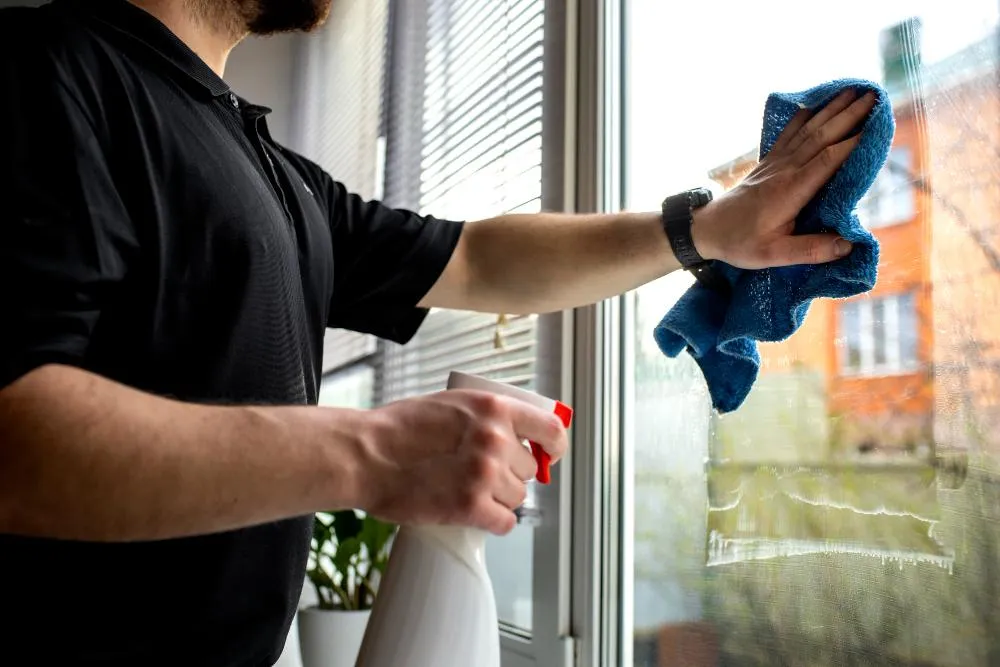
How to Clean Window Blinds: Quick Tips on How to Clean Them Like a Pro
Ever walk past your window blinds, do a quick double-take, and cringe at the layer of dust clinging stubbornly to each slat? Trust us, you’re not alone. We’ve been there: squinting through the grime, wondering how on earth those blinds went from crisp and clean to, well, basically a dust magnet. The truth is, dirty window blinds aren’t just an eyesore. They can actually drag down your whole room’s vibe and, worse yet, mess with your indoor air quality. (Yup, all that dust isn’t just sitting pretty—it’s circulating.)
So what’s the real problem? Most of us just don’t know the best way to clean blinds without turning the whole thing into a weekend-long chore. We ignore it until it’s bad enough to notice, then dread the hassle. But here’s the good news: cleaning window blinds—whether they’re wood, vinyl, fabric, or aluminum—doesn’t have to be complicated. In fact, with the right tips, a little elbow grease, and maybe a trick or two from the pros, you can keep your blinds looking fresh and extend their lifespan. (Plus, it’ll make your next spring cleaning a whole lot less terrifying.)
Why Clean Window Blinds Regularly?
Let’s be honest: Blinds are the unsung heroes of window treatments. They block harsh sun, add privacy, and—when they’re clean—make your place look sharp. But when neglected, they go from hero to zero real fast. So, why bother with regular cleaning?
Health and Air Quality
Here’s the thing: Dust on your blinds isn’t just unsightly—it’s a sneaky culprit for poor indoor air quality. According to the EPA, indoor air can be up to five times more polluted than outdoor air. And a big chunk of that pollution? You guessed it—household dust. Dust mites, pollen, pet dander, and even mold spores love to hitch a ride on blinds, especially if you’ve got allergies or asthma in your household.
Aesthetics and Home Value
Dirty blinds drag down your room’s whole look, no matter how clean the rest of your space is. It’s like wearing a spotless outfit but forgetting to wash your shoes—people notice. If you’re prepping your home for sale or even just hosting friends, sparkling blinds add an instant boost to your home’s perceived value.
A 2024 survey found that 74% of buyers notice dirty windows and blinds during open houses. That’s a big deal if you’re looking to impress.
Blind Longevity and Maintenance
Here’s something most people don’t realize: Regular cleaning actually makes your blinds last longer. Dust, grime, and even moisture can break down materials over time, whether it’s wood warping, vinyl discoloring, or metal corroding. A bit of routine maintenance can stretch your investment years longer than neglect ever could.
So, keeping up with cleaning isn’t just about looks—it saves you money in the long run. And honestly, who wouldn’t want that?
Understanding Different Types of Window Blinds
Before you bust out the cleaning supplies, you need to know what you’re working with. Not all blinds are created equal—what works wonders on vinyl might ruin your wood blinds for good. Let’s break down the most common types, because understanding your blinds is half the battle.
Venetian Blinds
These are the classic horizontal slatted blinds, usually made from aluminum, PVC, or sometimes wood. They’re popular for their versatility and light control. But here’s the catch: all those slats? They’re dust magnets. Venetian blinds benefit from regular dusting and the occasional deep clean. Aluminum versions are pretty hardy, while wood needs a gentler hand.
Vertical Blinds
You’ll spot these in sliding doors and big windows. Vertical blinds are either fabric, vinyl, or a composite material. The vertical orientation means less dust settles, but they get grimy at the base where hands and pets brush past. Fabric vanes require special care—no dunking or scrubbing here!
Wooden Blinds
Nothing beats the warm, classic look of real wood. But wood blinds are sensitive to moisture and harsh chemicals. Too much water can warp or discolor them. For these, gentle dusting and the occasional wipe with a slightly damp cloth (followed by drying) is the way to go.
Faux Wood and Vinyl Blinds
Faux wood (often made from composite or PVC) is a champ in kitchens and bathrooms because it’s more moisture-resistant and durable. Vinyl blinds are no-nonsense and budget-friendly—plus, they can handle a good soak if needed.
Fabric Blinds and Shades
Roman shades and honeycomb (cellular) blinds fall into this category. Fabric blinds are trickier—you can’t just wipe them down. Some are even machine-washable, but always check the label or manufacturer’s website. Spot-cleaning is usually safest.
Pro Tip: If you’re not sure what your blinds are made of, do a spot test in an inconspicuous area before using any cleaning solution.
Check your manufacturer’s recommendations—some blinds have coatings that can be damaged by common cleaners.
Understanding your blinds isn’t just a nerdy detail—it’s the difference between a sparkling finish and a cleaning disaster.
Best Way to Clean Blinds: Step-by-Step Guide
Alright, let’s get to the good stuff: how to clean window blinds like a pro:
Quick Cleaning (Routine Dusting)
Sometimes, all your blinds need is a quick dust-off. Here’s how to keep dust from taking over:
Close the blinds so the slats are flat.
Use a microfiber cloth, duster, or even an old sock on your hand to wipe each slat. Start at the top and work your way down.
Flip the blinds to the other side and repeat. (Don’t skip this—dust collects on both sides!)
For vertical blinds, start at the top of each vane and wipe downward.
A microfiber duster is your best friend here. It grabs dust instead of just pushing it around. For tight spaces, a can of compressed air (like what you use for keyboards) can help blast out debris.
Deep Cleaning (For Grime and Stains)
If your blinds have sticky spots, stains, or just years of neglect, it’s time for a deeper clean.
Remove the blinds (if possible) for a thorough wash. Most vinyl and aluminum blinds can handle this, but check first!
Fill a bathtub with warm water, a squirt of mild dish soap, and a cup of baking soda for extra cleaning power.
Submerge the blinds and let them soak for 30 minutes.
Gently scrub with a soft brush or sponge. Focus on stains and sticky spots.
Rinse with clean water and dry completely with towels. Hang to air-dry before reinstalling.
For wood or faux wood blinds, never soak them. Instead, wipe each slat with a damp (not wet) cloth, then dry immediately. If you’re worried about water damage, use a wood-safe cleaner.
Spot Cleaning Tips
Life happens—kids, pets, and kitchen splatters can leave random gunk on your blinds. Here’s how to spot-clean safely:
Use a damp cloth with a tiny bit of dish soap for most stains.
For sticky spots, a little white vinegar diluted with water works wonders (but avoid vinegar on wood—it can dull the finish).
If you’re cleaning fabric blinds, blot stains with a clean towel and a drop of gentle detergent. Don’t rub—it can damage the fibers.
Always test your cleaner on a small, hidden spot first. Trust me, it’s better to be safe than sorry.
Window Blinds Maintenance: Pro Tips for Long-Lasting Clean
Here’s the thing: Keeping blinds clean is way easier than getting them clean. A little maintenance goes a long way, and it’ll save you serious time (and frustration) down the road.
Weekly and Monthly Habits
Dust weekly: Yes, it sounds like a lot. But if you swipe your blinds every week, each cleaning takes just a few minutes.
Spot-check monthly: Look for sticky spots or stains and deal with them immediately. The longer grime sits, the harder it is to remove.
Vacuum blinds: Use the brush attachment to gently suck up dust from fabric or delicate blinds.
A handheld vacuum makes quick work of blinds, especially in homes with pets (cat hair, be gone!).
Preventing Damage
Avoid harsh chemicals: Bleach and ammonia can strip finishes and fade colors.
Minimize moisture: Especially on wood—moisture can cause warping and mold.
Handle with care: Don’t bend or force slats when cleaning. It’s all too easy to snap one if you’re in a rush.
Here’s a trick: If you’re cleaning after a renovation or during allergy season, close your windows to keep dust from coming in. And if you’re painting nearby, cover blinds with a sheet to prevent splatters.
Seasonal Deep Cleans
Even if you keep up with maintenance, plan a deeper clean twice a year (spring and fall are perfect). Take blinds down, follow the deep cleaning steps above, and check for any signs of damage or wear.
If you spot cracked slats or broken cords, consider a quick repair—or, if they’re beyond fixing, get in touch for replacement options.
When to Call the Pros
Look, sometimes DIY just doesn’t cut it. Maybe you’ve got blinds in hard-to-reach places, specialty materials, or stains that just won’t budge. That’s where professionals come in—and yes, they can be a lifesaver.
What Pros Offer
Expertise on all materials: Pros know exactly how to treat wood, aluminum, fabric, and more—no guesswork.
Ultrasonic cleaning: This high-tech method uses sound waves to remove grime from every nook and cranny. It’s gentle but insanely effective.
Disassembly and reinstallation: No need to wrestle with awkward brackets or risk damaging your blinds.
Stain and odor removal: Pros can tackle tough stains (think nicotine, grease, or pet accidents) and leave your blinds smelling fresh.
When It’s Worth the Investment
Your blinds are especially valuable or delicate (like custom wood or high-end fabric).
You have allergies or health concerns that require a deep, thorough cleaning.
Time is tight, and you just want the job done right without the hassle.
Professional cleaning ranges from $10-$30 per blind, depending on material and size. For large homes or specialty blinds, it can be money well spent. It’s a total game-changer if you’re prepping for a big event, selling your home, or just want that “wow” factor without breaking a sweat.
Conclusion
Let’s wrap this up: Cleaning your window blinds doesn’t have to be a dreaded, all-day affair. With the right know-how, a little consistency, and a few handy tricks, you can keep your blinds looking sharp—and your air cleaner, too. Whether you’re a DIY dynamo or prefer to call in the pros, the key is to make cleaning a habit, not a once-a-year ordeal.
So, next time you catch a glimpse of dusty blinds, don’t sigh and walk away. Grab a microfiber cloth, set a timer for 10 minutes, and tackle it. Your future self (and your sinuses) will thank you. And if you ever need help or want a pro-level clean, reach out to Pros Shades and Blinds—we’re always here to help you keep your windows (and your home) looking their best.
